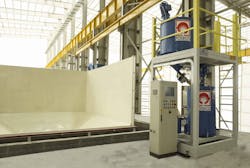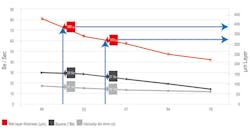Latest from Melt/Pour
The science of making molds and cores has advanced considerably in the past decade, and the efforts to improve metal quality are constant. But, what can be done to improve the result when the metal meets the mold?
Earlier this year Sheffield Forgemasters International Ltd. reported it is the first foundry in the U.K. to adopt a state-of-the-art mold and core coating technology, improving the quality of its large-dimension, high-integrity castings, and establishing more efficient production processes in the bargain. Forgemasters is a multi-faceted engineering group with specialties in several critical energy markets, including nuclear power plants and offshore drilling platforms. The group’s cast products represent huge investments of time and capital, and its customers have high stakes riding on the performance of these parts.
The coating process Forgemasters adopted is called Coating Preparation Plant (CPP), developed specifically for metalcasting operations and distributed exclusively by Foseco International Ltd.
Coating the mold is a common practice for foundries, to prevent interaction between the metal and mold, and to promote better surface finish and reduce cleaning and re-work requirements after casting. Forgemasters uses a two-part coating: Foseco’s SEMCO Coating 9223 as an undercoat and SEMCO Zir 7300SF as a topcoat. “The undercoat is designed to seal the surface and prevent metal from penetrating into the voids between sand grains,” explained Tim Birch, Foseco’s International Marketing Manager - Mold & Core. “The topcoat acts as a highly refractory protective layer on top of the sand preventing metal/mold interaction.
“The coatings are applied one after the other with no need to dry the undercoat prior to the application of the top-coat,” he continued, making a point about the efficiency of the CPP system in operation. He noted also that CPP is not restricted to these particular coatings: it works effectively with the full range of coating products that Foseco has developed.
“The need for such equipment is based on foundries’ ongoing need to consistently apply the correct layer thickness of coating,” Birch said, “as variations in applied layer thickness can lead to poor cast surface finish due to interaction between the molten metal and the mold if the coating layer is too thin, or the risk of dimensional inaccuracies, coating scabbing or poor surface finish due to runs or drips if the coating layer is too thick.”
Forgemasters’ manufacturing complex at Sheffield, England, includes electric arc furnace melting and casting for ingots, foundry and forging operations, as well as large-dimension machining capabilities.
The 10,000-metric tons/year foundry pours ladles of carbon or stainless steel up 100 metric tons, for products with maximum dimensions of 16×7.6×4.6 meters. It is able to produce castings weighing up to 350 metric tons, and engineering, patternmaking, ultrasonic testing, and heat-treatment of finished products are done on site.
As Tim Birch recalled, the foundry had been using an “undercoat/topcoat concept” for its molds, but continued to have a high degree of mold penetration. That resulted in excessive production delays, and increased fettling costs for finished castings. Foseco’s advice was sought to reduce the metal penetration, and to advise a best practice for mold coating at Sheffield Forgemasters.
“The principle change was to convert the accepted practice of undercoat spray application to flow-coating,” Birch explained. “With the correct dilution of SEMCO Coating 9223, flow-coating allowed deeper penetration of the coating into the core/mold surface, thus reducing the possibility of metal being forced into the substrate.”
Once Forgemasters had adopted flow coating for both applications, Foseco’s challenge was to devise a method for delivering the coating in “a consistent reproducible dilution, regardless of other influencing factors,” he noted.
Essential Consistency
To control the thickness of the coating, it is essential to have consistent dilution. Birch recalled that customarily this has been achieved by conducting intermittent measurements, using a flow cup or a Baume stick. “Both methods are prone to human error,” he said, “and the intermittency of measurements means the process is not continuously under control.”
Initially, the intermittency and human error were addressed with a device developed by ProService, an Italian firm that is Foseco’s development partner for the CPP. The ProService “Density Sentinel” probe is placed within the coating and continually monitors and records coating density. From there, according to Birch, “the natural development was to use the data provided to automatically add more coating or dilutant (i.e., water or solvent) to ensure that the density of the coating is maintained at a pre-determined constant and hence maintained in the optimum state for consistent application.”
After several iterations, he explained these developments became the Coating Preparation Plant, incorporating the Density Sentinel measurement probe, automatic dosing of coating and dilutant, homogenization of the prepared coating, and automatic cleaning of the Density Sentinel unit.
For the Sheffield Forgemasters installation, Birch added that the CPP had to be capable of remote control, for the convenience of operators. The unit had to have a low-maintenance design too, including automated self-cleaning functionality for the Density Sentinel in an ultrasonic tank.
The mold and core coating process operating now at Forgemasters is a two-part system, consisting of two CPP units, and a dedicated core and mold drying oven, supplied by Omega Foundry Machinery Ltd., to control the drying of the coating.
The main elements of the CPP installation are the application area, the coating holding tank, the coating preparation tank, a control panel, the Density Sentinel and level probes, pneumatic valves to control dosing of coating and dilutant, an ultrasonic cleaning station, and filter units to collect loose sand.
In the coating application area, the CPP delivers coating at the correct dilution for application. “If the coating supplied is not to be used immediately, it can be circulated back to the CPP to guarantee it is always homogenized and at the correct dilution,” Birch noted.
Undiluted coating is stored in the holding tank, which may be a fixed storage vessel supplied by drum or fixed bulk storage vessel, or a platform that accepts returnable containers with integral mixer. The preparation tank receives the undiluted coating and the solvent or water, and homogenizes the solution using an integral mixer that ensures an efficient blend without sedimentation.
For excess coating that is drained from the molds/cores during the flow-coating process, filter units are installed to collect loose sand and other particulates.
The control panel contains the PLC controller, a touchscreen HMI for user input, and an output monitor. Also, the panel displays the output from the Density Sentinel and, based on dilution curve data for the specific coatings in use, activates the pneumatic valves that dose either coating or dilutant.
“The density required is set by the user, as are the timers that control mixing frequency and automatic cleaning cycles,” Tim Birch explained.
The control panel also monitors coating levels within the preparation tank, which ensures the correct amount of coating is always available. The control panel is Web-enabled, and so available for software updates or remote monitoring as needed.
Continuous Measuring, Monitoring
The Density Sentinel and level probes continuously measure the coating density and monitor minimum/maximum coating levels and pneumatic valves control dosing of the coating and the dilutant.
Forgemasters’ CPP installation includes an ultrasonic cleaning station: the Density Sentinel is automatically removed from the coating on a regular basis for thorough cleaning.
Tim Birch indicated that the CPP technology has been installed for other foundries too. Although the process is the same, each installation is customized to match a foundry’s requirements of size, application method, coating delivery and integration into the production process.
For Forgemasters the process not only ensures uniform composition and thickness of its mold coating, it reduces preparation time, improves casting surface finish, and makes it easier to remove refractory from the casting. Also, it reduces the amount of work needed to clean sand and resin from the casting once it is removed from the mold.
“It essentially enables us to create an even coating of the molds and cores, and because the control system is automated, it eliminates manual preparation of the coating slurry,” explained Simon Alexander, Sheffield Forgemasters’ foundry director. “As the new process works on a closed system, we have also dramatically reduced the amount of waste slurry.
“We use water-based zircon slurry,” he continued, “which used to be applied following dilution and quality-control testing by hand, which inevitably leads to inconsistent coating quality and thickness.
“Seasonal temperature variations in the foundry also complicate the traditional, manual approach,” Alexander noted.
The temperature-controlled slurry is automatically diluted and tested, and then pumped to an application nozzle for the operator to direct over the sand mold. The uniform composition and density ensure that the cores and molds are flow coated effectively, which achieves a constant and accurate layer thickness..
“Any excess coating is collected and recycled,” according to Alexander.
Forgemasters recently reported it is conducting trials to develop a spray application for use on large molds or core sections that cannot be directly flow-coated.
The second stage of the Forgemasters installation is the mobile drying oven. After the coating process is complete, the oven reduces drying time for coatings from several days to just four hours, from start to finish. The rail-mounted oven is able to service four separate areas, each one measuring 4-m. square, where items are placed, ready for drying.
Forgemasters indicated its automated coating and drying system represented a “six-figure cost” that is part of a continuing capital improvement program at the Sheffield Works. The program reached £50 million ($76.3 million) recently, and the company has stated it is diverting all profits into plant improvements, “in order to capitalize on technology and skill to break new markets,” according to a statement.
“Part of Forgemasters’ ongoing strategy is to refine systems and invest in technology where it can demonstrate a measurable improvement to what we do. The new coatings system is a prime example of that approach,” Simon Alexander explained. “We are champions of technology, which helps to make our products the best that they can be, and we are pleased to be the first adopters of the system in the U.K.”












